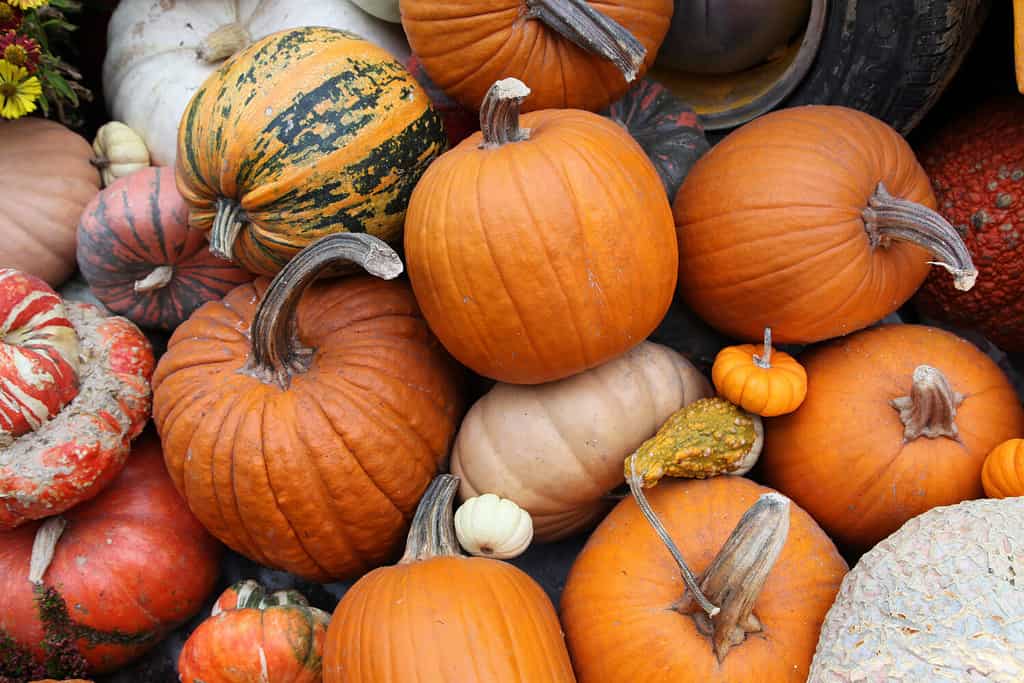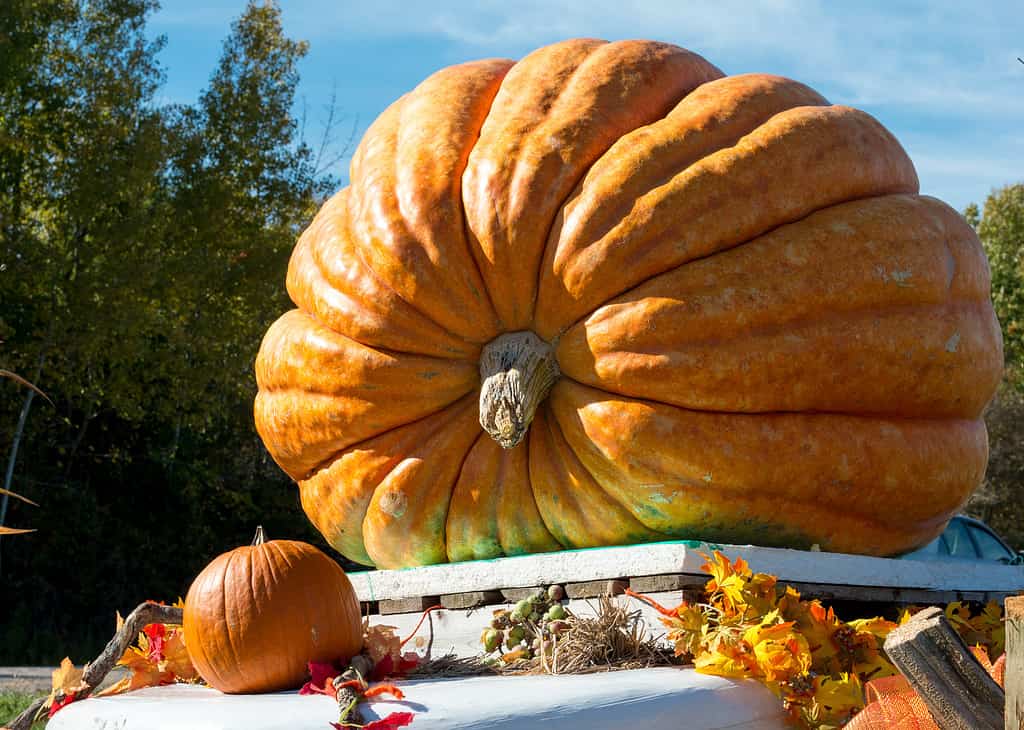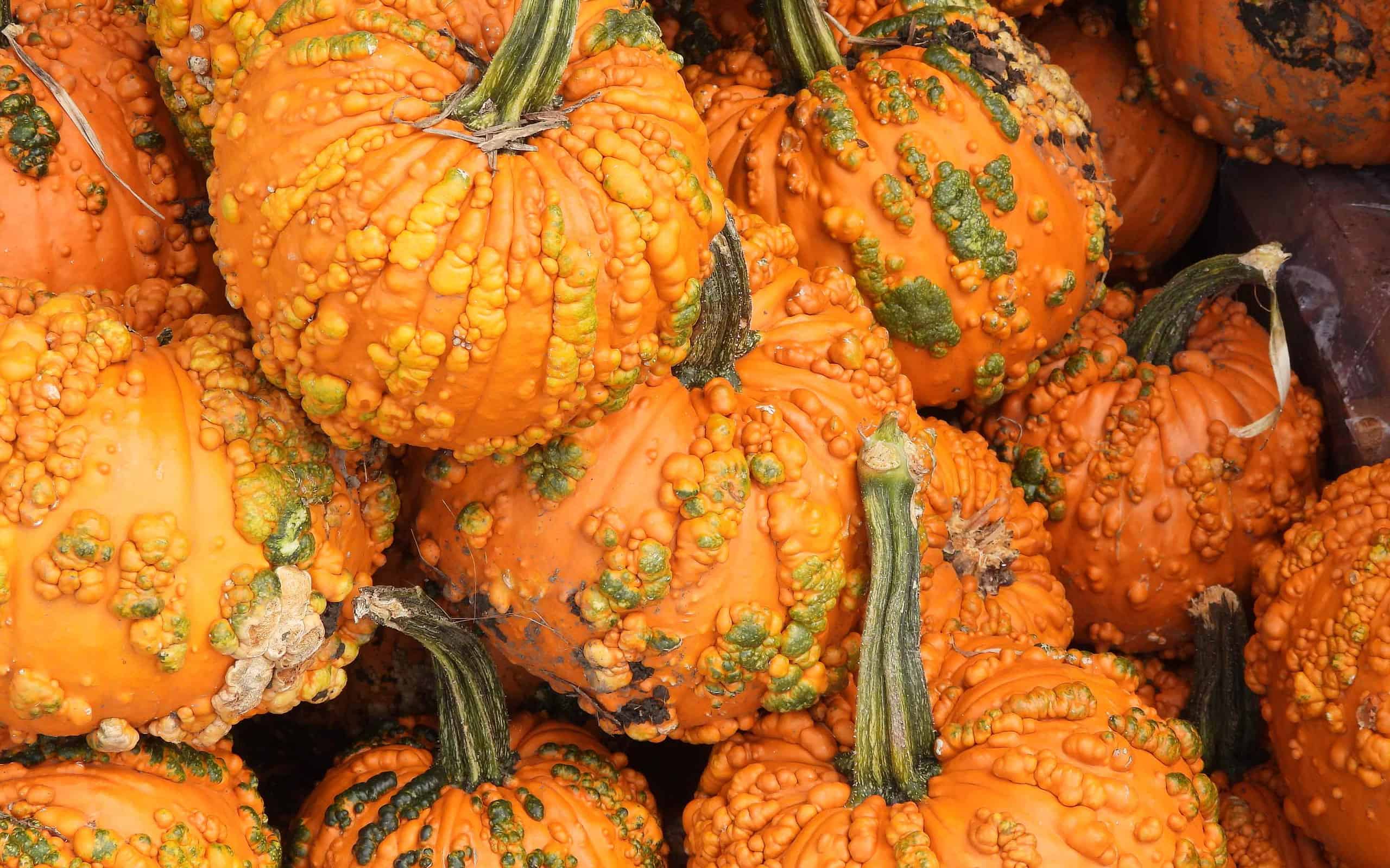It’s that time of year again when the air gets crisper, the leaves turn a fiery hue, and pumpkins begin to ripen in the patch. Whether you’re a seasoned pumpkin grower or a first-time gardener, knowing when to pluck those perfect pumpkins and how to store them can make all the difference in preserving their freshness and flavor. In this article, we’ll guide you through the art of determining the right time for a pumpkin harvest and provide some nifty tips for keeping them in tip-top shape.
Signs Your Pumpkins Are Ready for Harvest
1. Mature Coloration
Determining when your pumpkins are ready for harvest can be quite straightforward when you pay attention to their mature color. The mature color of a pumpkin is a reliable indicator of its readiness for picking. When pumpkins are perfectly ripe, they take on a rich, dependable hue that is unique to that kind.
For instance, when it’s time to harvest your usual orange pumpkins, they should have a deep, even orange color. These vibrant orange shades signal that the pumpkin has fully matured and is likely to have the best flavor and texture.
It’s essential to inspect your pumpkins closely, as immature ones may have a greenish tint or uneven coloring. Additionally, a ripe pumpkin should have firm skin that cannot be easily punctured with a fingernail. When the skin is hard and impervious to injury, the pumpkin is ready for plucking and in its best state.
It’s a good idea to become familiar with the features of the pumpkins you’ve planted because the precise shade and look of ripe pumpkins may vary depending on the variety you’re cultivating. You can make sure that you harvest your pumpkins at the pinnacle of their flavor and quality by paying special attention to the mature color of your pumpkins.
2. Hardened Rind
One of the most reliable indicators that your pumpkins are ready for harvest is the hardened rind they develop as they mature. The rind, or skin, of a pumpkin, becomes tougher and more rigid as it ripens. This hardening of the rind is a clear sign that the pumpkin is at its peak for picking.
When you gently press your fingernail against the pumpkin’s skin, a mature pumpkin will resist puncture. In contrast, an immature pumpkin will have a softer, more pliable rind that yields to pressure. This simple test is a surefire way to confirm if your pumpkins are ready for harvest.
The hardened rind not only indicates maturity but also contributes to the pumpkin’s long-term storage ability. Pumpkins with a tough rind are less prone to rot and damage, making them ideal candidates for storage throughout the fall and even into the winter months.
It’s essential to monitor your pumpkins regularly as they approach maturity, looking for signs of the hardened rind along with the appropriate coloration. By combining these two cues, you can be confident that you’re harvesting your pumpkins at the optimal time for the best taste and preservation.

Harvest-ready pumpkins will have a tough, solid rind that doesn’t offer any give when touched.
©Jacqui Martin/Shutterstock.com
3. Sturdy Stems
An excellent method for determining the readiness of your pumpkins for harvest is to inspect their stems. A sturdy stem is a clear indicator that the pumpkin is mature and ready to be picked.
When a pumpkin reaches its ideal level of ripeness, its stem becomes robust and well-attached to the fruit. This signifies that the pumpkin has finished growing and is at its peak flavor and quality. To check the stem, grasp it firmly and try to lift the pumpkin. If the stem holds firmly without bending or breaking, it’s a good sign that the pumpkin is ready to be harvested.
On the other hand, if the stem is weak or brittle and easily separates from the pumpkin with minimal effort, it’s a clear indication that the pumpkin is not yet mature. In such cases, it’s advisable to leave the pumpkin on the vine for a bit longer to allow it to develop further.
Inspecting the stems is a practical and simple way to gauge the readiness of your pumpkins. It ensures that you harvest them at the right time, maximizing their flavor and storage potential. So, keep an eye on those sturdy stems, and you’ll have perfectly ripe pumpkins for your autumn festivities.
4. Dull-Looking Skin
Another reliable method for determining the optimal time to harvest your pumpkins is to observe the skin’s appearance. When a pumpkin is ready for picking, its skin takes on a dull, matte finish. This subtle transformation in skin texture is a valuable indicator of maturity.
A pumpkin’s skin starts with a glossy sheen when it’s still growing, but as it ripens, it loses this shine and becomes more subdued in appearance. This change signifies that the pumpkin has reached its peak flavor and is ready to be harvested.
To check for dull-looking skin, examine the pumpkins closely, paying attention to their surface. If the skin appears glossy, it’s a sign that the pumpkin is not yet fully mature. However, when you notice a matte, slightly faded appearance, it’s an indication that the pumpkin is at its prime for picking.
This visual cue is especially helpful when combined with other signs of ripeness, such as a sturdy stem and the appropriate coloration. By assessing the skin’s dullness, you can confidently harvest your pumpkins at the right time, ensuring they have the best taste and texture for your autumn culinary endeavors or decorative displays.
5. Large Size
Gauging the size of your pumpkins is one of the simplest ways to determine if they are ready to be picked. As pumpkins grow and mature, they tend to reach a certain size that signals their readiness for picking.
A mature pumpkin will typically have reached its expected size according to its variety. For instance, if you’re growing a particular type of pumpkin known to be around eight to 10 inches in diameter, you can confidently consider it ready for harvest once it reaches that size range. It’s important to consult the guidelines specific to the pumpkin variety you’re growing, as sizes can vary widely.
Keep an eye on your pumpkins as they develop, and regularly measure their diameter to track their progress. When they attain the anticipated size, it’s a good indication that they’ve reached their peak ripeness. Be cautious not to wait too long, as overly large pumpkins can lose flavor and tenderness.
By monitoring the size of your pumpkins and comparing them to the expected dimensions, you can ensure that you harvest them at the optimal time for the best taste and texture. This simple yet effective method helps you enjoy the full potential of your pumpkin harvest for both culinary and decorative purposes.

Large pumpkins are usually ready for harvest, but be careful not to wait too long as extra-large pumpkins tend to lack flavor.
©Jun Zhang/iStock via Getty Images
6. Hallow Sound When Tapped
Our final and probably most clever way to determine if your pumpkins are ripe for harvest is to listen for a hollow sound when you gently tap them. This auditory cue can be a reliable indicator of their readiness.
When a pumpkin is fully mature, the flesh inside undergoes changes that create an air gap between the skin and the flesh. This space is what produces the hollow sound when you tap it. On the other hand, if the pumpkin is still immature, the flesh remains densely packed against the skin, and tapping it will result in a dull, solid sound.
To perform this test, use your knuckles or a small tool to tap the pumpkin’s surface gently. If you hear a hollow, echoing sound, it suggests that the pumpkin is ripe and ready to be harvested. Conversely, if the sound is dull and lacks resonance, the pumpkin may need more time to reach maturity.
This method is a valuable addition to other visual cues, such as skin color and stem condition when assessing pumpkin ripeness. The hollow sound test helps ensure that you pick your pumpkins precisely when they’re at their flavor and texture peak, whether you plan to use them for cooking or decoration.
Storage Tips and Methods for Pumpkins
1. Keep in a Cool, Dry Place
Our first effective method to store your pumpkin harvest is by keeping them in a cool, dry location. After the excitement of harvesting your pumpkins, proper storage is crucial to maintain their freshness and longevity.
Pumpkins should ideally be kept in a location where the temperature stays between 50 and 55 degrees F. This chilly, but not freezing, atmosphere aids in preventing ripening or decay before its time. Maintaining a dry environment is equally crucial since too much moisture may encourage the growth of mold and cause food to deteriorate. Ensure good ventilation to prevent humidity buildup around your pumpkins.
Place your pumpkins on a dry, elevated surface like wooden pallets or shelves, allowing air to circulate them. Avoid stacking them directly on the ground, as this can trap moisture and lead to decay. Inspect your stored pumpkins periodically, removing any that show signs of softening or damage to prevent the spread of rot to others.
2. Cure Your Pumpkins
Curing is an effective method to store your pumpkin harvest and prolong its freshness. After harvesting, allow your pumpkins to cure for about ten days to two weeks. This process toughens the skin, heals minor cuts or bruises, and enhances its flavor and keeping qualities.
To cure pumpkins, start by placing them in a warm and well-ventilated area, preferably around 80 to 85 degrees F. A sunny porch or a dry garage works well. Arrange them in a single layer, ensuring they don’t touch each other. This promotes proper air circulation.
During curing, the pumpkins’ outer skin will harden and become less susceptible to rot or moisture loss. After curing, store them in a cool, dry place with good ventilation, like a cellar or pantry. Keep them on elevated surfaces, away from direct contact with the ground.
3. Freeze Your Pumpkins
Freezing is a practical method for preserving your pumpkin harvest. It’s particularly useful if you have an abundance of pumpkins and want to enjoy them throughout the year.
First, peel and cube the pumpkin, removing the seeds and stringy bits. Next, blanch the pumpkin pieces by briefly immersing them in boiling water for about two to three minutes. This step helps preserve their color and texture. The pieces should then be properly drained and promptly chilled in cold water.
Place the dried pumpkin cubes in a single layer, ensuring they don’t touch, on a baking sheet. Put them in the freezer for a few hours or until they are hard. Transfer the frozen cubes to airtight freezer bags or containers, taking care to remove as much air as you can to avoid freezer burn.
Label the containers with the date and store them in your freezer. Pumpkin cubes can be used in various recipes like soups, pies, and smoothies, providing a taste of autumn even amid winter.
4. Make Puree
One excellent method for storing your pumpkin harvest is by pureeing them. This approach allows you to conveniently preserve pumpkin in a form that’s versatile and ready for various culinary uses.
To start, peel the pumpkin, remove the seeds and strings, and cut it into small, manageable pieces. Then, steam or boil the pumpkin until it’s soft and easily mashable. Drain it well to remove excess moisture. The pumpkin may now be pureed in a food processor or blender to get a smooth, creamy consistency.
After pureeing, divide it into portions and place them in airtight containers or freezer bags, making sure to leave space for expansion while freezing. To maintain track of freshness, mark the containers with the date and the number of contents.
Pies, soups, muffins, and many other foods may be made with frozen pumpkin puree. It keeps the mouthwatering pumpkin flavor while offering a quick and simple method to enjoy your harvest all year long.

Pumpkin puree is the key ingredient in the ever-popular fall staple pumpkin pie.
©Brent Hofacker/Shutterstock.com
5. Make Pumpkin Preserves
Preserving your pumpkin harvest through pumpkin preserves is a delightful and practical option. It allows you to capture the rich flavor of pumpkins in a delicious and versatile form.
To make pumpkin preserves, begin by peeling and cubing the pumpkin, removing the seeds and any stringy bits. Then, cook the pumpkin cubes in a syrup made of sugar, water, and spices like cinnamon and cloves. Simmer the mixture until the pumpkin becomes tender and takes on the sweet, aromatic flavors of the syrup.
Once the pumpkin is soft and the syrup has thickened, ladle the preserves into sterilized jars, leaving some headspace. Seal the jars, and process them in a water bath canner to ensure proper preservation.
6. Make and Freeze Pumpkin Soup
Creating and freezing pumpkin soup is an excellent method to store your pumpkin harvest while savoring the flavors of autumn in the months ahead. To begin, peel and dice your pumpkin, eliminating seeds and any fibrous material. The onion, garlic, and your desired seasonings should all be simmered with the pumpkin pieces until they are soft and delicious.
Using a blender or immersion blender, purée the mixture once the ingredients have been cooked to perfection. To attain the correct consistency and flavor, add cream or broth. Before portioning the soup into airtight containers or freezer bags with room for expansion, let the soup cool to room temperature. Label each container with the date to track freshness.
Freezing pumpkin soup preserves its rich taste and makes for quick, hearty meals during colder months. Simply thaw, reheat, and enjoy the comforting, homemade goodness.
Summary of Clear Signals Your Pumpkins Are Ready to Be Harvested (Plus Tips on Storing Them)
| # | Harvest Signals | Storage Tips |
|---|---|---|
| 1 | Mature Coloration | Keep in a Cool, Dry Place |
| 2 | Hardened Rind | Cure Your Pumpkins |
| 3 | Sturdy Stems | Freeze Your Pumpkins |
| 4 | Dull-Looking Skin | Can Your Pumpkins |
| 5 | Large Size | Make Puree |
| 6 | Hallow Sound When Tapped | Make Pumpkin Preserves |
Thank you for reading! Have some feedback for us? Contact the AZ Animals editorial team.








